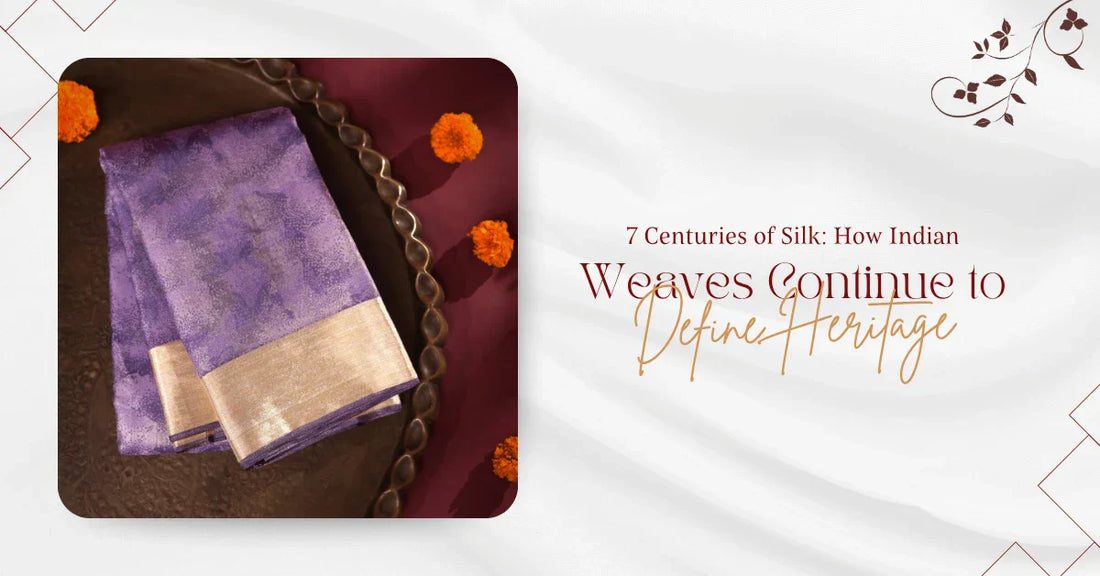7 Centuries of Silk: How Indian Weaves Continue to Define Heritage
Introduction
For over seven centuries, Indian silk heritage has been more than just fabric — it has been a living symbol of grace, pride, and continuity. From the lustrous Kanchipuram silks of Tamil Nadu to the exquisite Banarasi brocades of Varanasi, every weave carries stories of devotion, artistry, and tradition.
Through empires, generations, and changing trends, silk has remained the heart of Indian attire — an heirloom passed down, a statement of identity, and a work of art in itself. Even today, handloom silk continues to define our cultural heritage with beauty that never fades.
The Origins of India’s Silk Heritage
The story of silk in India began centuries ago, tracing back to royal courts, temples, and trade routes that connected our weavers to the world. Ancient travelers from China and Persia recorded India’s mastery in sericulture and weaving, while rulers like the Cholas and Mughals encouraged artisans to create intricate designs for deities and royalty.
In regions like Kanchipuram and Varanasi, silk became sacred — used in temple offerings and rituals. Over time, these weaves evolved from spiritual art into a symbol of prestige, admired both in India and abroad.
Evolution Through Dynasties and Design
Each dynasty that ruled India left its own imprint on the country’s silk craftsmanship.
- The Cholas perfected Kanchipuram silk, with temple-inspired borders and vibrant colour contrasts.
- The Mughals introduced zari work and delicate floral patterns influenced by Persian aesthetics.
- The Vijayanagar Empire expanded the silk trade across South India, supporting hundreds of weaving families.
- This continuous evolution made Indian weaves a reflection of both cultural depth and creative diversity — uniting art, devotion, and innovation.
The Soul of Handloom — The Weaver’s Art
Behind every handwoven silk saree lies a story of patience and mastery. For generations, families of artisans have passed down weaving secrets from one hand to another.
Each saree takes weeks or even months to complete, depending on the complexity of its motifs. The rhythm of the loom, the interplay of warp and weft, and the gleam of zari threads all combine to create magic that no machine can replicate.
Sustainability Rooted in Tradition
Long before sustainability became a buzzword, India’s silk weavers practiced it naturally. Handloom production uses minimal energy, supports local economies, and emphasizes quality over quantity.
Every saree is unique — designed to last decades, even generations — making it a timeless example of sustainable luxury.
Regional Diversity That Defines Indian Silk
India’s silk tradition is as vast as the nation itself. Each region has its distinct style, technique, and emotion woven into its fabric:
- Kanchipuram Silk (Tamil Nadu): Known for temple borders, heavy contrast colours, and durability.
- Banarasi Silk (Uttar Pradesh): Famous for zari, brocade, and Mughal-inspired designs.
- Mysore Silk (Karnataka): Elegant sheen and soft texture with minimal motifs.
- Assam Silk (Eri, Muga, Pat): Naturally golden, eco-friendly, and distinctive in shine.
- Pochampally Ikat (Telangana): Recognized for geometric patterns and tie-and-dye precision.
- Together, these styles create the map of India’s silk heritage, each telling a different story yet sharing the same soul.
Silk in Rituals, Royalty, and Modern India
Silk has always been more than a textile — it’s part of India’s spiritual and emotional fabric. For centuries, it has draped deities, adorned brides, and graced royal gatherings.
Even in today’s world of changing fashion, silk continues to evolve — appearing in fusion wear, bridal couture, and contemporary silhouettes while preserving its traditional identity.
At Sri Krishna Silks, this legacy is carried forward with pride — offering handcrafted sarees that combine ancient weaves with modern elegance for today’s generation.
The Legacy Lives On
Seven centuries have passed, yet the charm of Indian silk remains undimmed. It continues to connect the past with the present, the artisan with the admirer, and tradition with timeless beauty.
Every weave narrates a story — of hands that worked tirelessly, of dreams woven into threads, and of heritage that refuses to fade.
Conclusion
The Indian silk heritage is not just an art form; it’s a living bridge between eras. Every saree you drape carries within it centuries of devotion, skill, and identity.
Whether worn for weddings, festivals, or treasured moments, a silk saree reflects who we are — proud, graceful, and rooted in culture.
Explore the Heritage Collection by Sri Krishna Silks and embrace a legacy that continues to define Indian elegance.



